 HOME
- EXHIBITION
OVERVIEW - OBJECT
LIST
HOME
- EXHIBITION
OVERVIEW - OBJECT
LISTSECTIONS: I. America as Refuge - II. 18th Century America III. American Revolution - IV. Congress of the Confederation - V. State Governments VI. Federal Government - VII. New Republic I. America as a Religious Refuge:
|
 Execution
of Mennonites Execution
of MennonitesThis engraving depicts the execution of David van der Leyen and Levina Ghyselins, described variously as Dutch Anabaptists or Mennonites, by Catholic authorities in Ghent in 1554. Strangled and burned, van der Leyen was finally dispatched with an iron fork. Brachts Martyrs Mirror is considered by modern Mennonites as second only in importance to the Bible in perpetuating their faith. Murder of
David van der Leyen and Levina Ghyselins, Ghent,
1554
John Ogilvie
(Ogilby), Societas Jesu, 1615 |
The religious persecution that drove settlers from Europe to the British North American colonies sprang from the conviction, held by Protestants and Catholics alike, that uniformity of religion must exist in any given society. This conviction rested on the belief that there was one true religion and that it was the duty of the civil authorities to impose it, forcibly if necessary, in the interest of saving the souls of all citizens. Nonconformists could expect no mercy and might be executed as heretics. The dominance of the concept, denounced by Roger Williams as "inforced uniformity of religion," meant majority religious groups who controlled political power punished dissenters in their midst. In some areas Catholics persecuted Protestants, in others Protestants persecuted Catholics, and in still others Catholics and Protestants persecuted wayward coreligionists. Although England renounced religious persecution in 1689, it persisted on the European continent. Religious persecution, as observers in every century have commented, is often bloody and implacable and is remembered and resented for generations. |
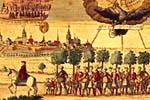 The Expulsion of the
Salzburgers The Expulsion of the
SalzburgersOn October 31, 1731, the Catholic ruler of Salzburg, Austria, Archbishop Leopold von Firmian, issued an edict expelling as many as 20,000 Lutherans from his principality. Many propertyless Lutherans, given only eight days to leave their homes, froze to death as they drifted through the winter seeking sanctuary. The wealthier ones who were allowed three months to dispose of their property fared better. Some of these Salzburgers reached London, from whence they sailed to Georgia. Others found new homes in the Netherlands and East Prussia.
Engraving by David Becklin from Die Freundliche Bewillkommung Leipzig: 1732 Rare Books Division. The New York Public Library, Astor, Lenox and Tilden Foundations (7)
Engraving from [Christopher Sancke?], Ausfhrliche Historie derer Emigranten oder Vertriebenen Lutheraner aus dem Erz-Bistum Salzburg, Leipzig: 1732 Rare Book and Special Collections Division, Library of Congress (8)
Lithograph in A. Challe, Histoire des Guerres du Calvinisme et de la Ligue dans l'Auxerrois, le Snonais et les autres contres qui forment aujourd'hui le dpartement de l'Yonne Auxerre: Perriquet et Rouille, 1863 General Collections, Library of Congress (2)
Engraving from Richard Verstegen, Thtre des Cruautez des Hrtiques de notre temps Antwerp: Adrien Hubert, 1607 Folger Shakespeare Library, Washington, D.C. (3)
Engraving from Matthew Taylor, Englands Bloody Tribunal: Or, Popish Cruelty Displayed . . . . London: J. Cooke, 1772 Rare Book and Special Collections Division, Library of Congress (5)
from Mathias Tanner, Die Gesellshafft Jesu biss zur vergiessung ihres Blutes wider den Gotzendienst Unglauben und Laster . . . Prague: Carlo Ferdinandeischen Universitat Buchdruckeren, 1683 Rare Book and Special Collections Division, Library of Congress (6)
Engraving from John Fox, The Third Volume of the Ecclesiastical History containing the Acts and Monuments of Martyrs. . . . London: Company of Stationers, 9th edition, 1684 Rare Book and Special Collections Division, Library of Congress (9)
Woodblock print from The New-England Primer Improved Boston: A. Ellison, 1773 Rare Book and Special Collections Division, Library of Congress (10) |
CROSSING THE OCEAN TO KEEP THE FAITH:
THE PURITANS
| Puritans were English Protestants who
wished to reform and purify the Church of England of what they
considered to be unacceptable residues of Roman Catholicism. In the
1620s leaders of the English state and church grew increasingly
unsympathetic to Puritan demands. They insisted that the Puritans
conform to religious practices that they abhorred, removing their
ministers from office and threatening them with "extirpation from
the earth" if they did not fall in line. Zealous Puritan laymen
received savage punishments. For example, in 1630 a man was
sentenced to life imprisonment, had his property confiscated, his
nose slit, an ear cut off, and his forehead branded "S.S." (sower of
sedition).
Beginning in 1630 as many as 20,000 Puritans emigrated to America from England to gain the liberty to worship God as they chose. Most settled in New England, but some went as far as the West Indies. Theologically, the Puritans were "non-separating Congregationalists." Unlike the Pilgrims, who came to Massachusetts in 1620, the Puritans believed that the Church of England was a true church, though in need of major reforms. Every New England Congregational church was considered an independent entity, beholden to no hierarchy. The membership was composed, at least initially, of men and women who had undergone a conversion experience and could prove it to other members. Puritan leaders hoped (futilely, as it turned out) that, once their experiment was successful, England would imitate it by instituting a church order modeled after the New England Way. |
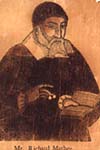 Richard
Mather Richard
MatherRichard Mather (1596-1669), minister at Dorchester, Massachusetts, 1636-1669, was a principal spokesman for and defender of the Congregational form of church government in New England. In 1648, he drafted the Cambridge Platform, the definitive description of the Congregational system. Mathers son, Increase (1639-1723), and grandson, Cotton (1663-1728), were leaders of New England Congregationalism in their generations. Richard
Mather Courtesy of the American Antiquarian Society, Worcester, Massachusetts (11)
Cottonus
Matherus S. theologieae doctor regia societas Londonensis. . .
. Prints & Photographs Division, Library of Congress (12)
|
THE BIBLE COMMONWEALTHS
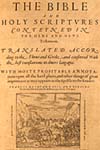 The Geneva
Bible The Geneva
BibleThe Geneva Bible was published in English in Geneva in 1560 by English reformers who fled to the continent to escape persecutions by Queen Mary. Their leader was William Whittingham, who married a sister of John Calvin. The Geneva Bible was used by the Pilgrims and Puritans in New England until it was gradually replaced by the King James Bible. According to one twentieth-century scholar, "between 1560 . . . and 1630 no fewer than about two hundred editions of the Geneva Bible, either as a whole or of the New Testament separately, appeared. It was the Bible of Shakespeare and of John Bunyan and of Cromwells Army and of the Pilgrim Fathers." The Bible
and Holy Scriptures Conteyned in the Olde and Newe Testament.
|
The New England colonies have often been called "Bible Commonwealths" because they sought the guidance of the scriptures in regulating all aspects of the lives of their citizens. Scripture was cited as authority for many criminal statutes. Shown here are the two Bibles used in seventeenth-century New England and a seventeenth-century law code from Massachusetts that cites scripture. |
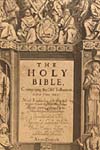 The King James
Bible The King James
BibleThe first edition of the King James Bible, also called the "Authorized Version," was composed by a committee of English scholars between 1607 and 1611. The first copy of the King James Bible known to have been brought into the colonies was carried by John Winthrop to Massachusetts in 1630. Gradually the King James Bible supplanted the Geneva Bible and achieved such a monopoly of the affections of the English-speaking peoples that a scholar in 1936 complained that many "seemed to think that the King James Version is the original Bible which God handed down out of heaven, all done up in English by the Lord himself."
London: Robert Baker, 1611 Rare Book and Special Collections Division, Library of Congress (15)
Revised and Reprinted [right page] [left page] Cambridge, Massachusetts: Samuel Green, 1672 Law Library, Rare Book Collection, Library of Congress (16)
Cambridge, Massachusetts: Stephen Daye, 1640 Rare Book and Special Collections Division, Library of Congress (17)
Translated into the Indian Language. . . . [left page] [right page] Cambridge, Massachusetts: Samuel Green and Marmaduke Johnson, 1663 Rare Book and Special Collections Division, Library of Congress (18) |
SECTIONS: I. America as Refuge - II. 18th Century America
III. American Revolution - IV. Congress of the Confederation - V. State Governments
VI. Federal Government - VII. New Republic
Go to:
Comments: Contact Us (07/21/2000)
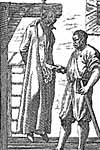
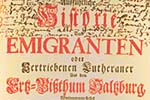
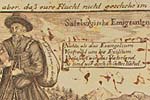



![Die Societas Jesu in
Europa, 1643-1644 [page 171]](images/vc6376th.jpg)
![Die Societas Jesu in
Europa, 1643-1644 [page 170]](images/vc6375th.jpg)
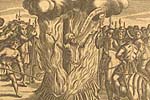
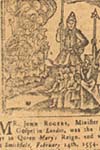
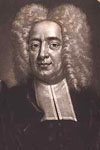
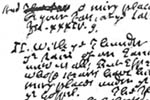
![The General Laws and
Liberties of the Massachusets Colony: Revised and Reprinted [right page]](images/vc6524th.jpg)
![The General Laws and
Liberties of the Massachusets Colony: Revised and Reprinted [left page]](images/vc6523th.jpg)
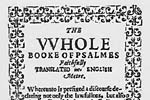
![The Holy Bible:
Containing the Old Testament and the New,Translated into the Indian
Language. . . . [right page]](images/vc6817th.jpg)
![The Holy Bible:
Containing the Old Testament and the New,Translated into the Indian
Language. . . . [left page]](images/vc6816th.jpg)